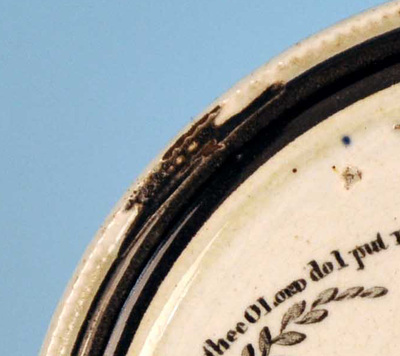|
One feature of Newbottle-attributed plaques appears to be clumsily applied black enamel. Even the plaque donated to the Victoria and Albert Museum (right below) by descendants of the owners of Newbottle High Pottery has a clumsily applied black border. This put me in mind of another Newbottle-attributed plaque from c1845, which also has smudgy black edges. Analysis of decoration is an imprecise science, but does provide a link, of sorts, between the c1830s plaques above and the mid 40s plaque below. There were a couple of other entries in Andrew D Fletcher's article The Newbottle Potteries that caught my eye. Firstly, the V&A doesn't appear to have listed all of the Fairbairn's gift in their online catalogue. Fletcher quotes, presumably from another V&A catalogue list, as follows: Earthenware pot and cover, painted in purple (gold) lustre. It stands 5 3/8 inches by 3 7/8 in diameter. The pot of inverted truncated conical form, with two adherent ring handles; the domed cover has a round knob. Both pieces painted with houses in landscapes. So this shows that Newbottle High Pottery was indeed producing items with purple lustre, in the 1830s, under Fairbairn's management. I've e-mailed the V&A for a photo, but as yet had no response. This adds strength to the Newbottle attribution of the 'group 2' transfers, which appear on purple/pink lustre plaques. The next extract from Fletcher explains how the Broderick and Beckwith partnership dissolved in 1852. It's unclear where this reference comes from. The said partnership between John Broderick and James Beckwith was dissolved by mutual consent. John Broderick departed this life, 4th February last, intestate, leaving Elizabeth his wife, and children William Wade, Edward, Robert, Margaret Jane & Elizabeth Julia Broderick. John being both an earthenware manufacturer and grocer and was indebted to William Goodburn on account of both trade businesses and William Wade Broderick inherited the aforesaid. William & Edward carried on earthenware manufacture and their mother carried on the grocery businesses. There are a few things of note here. John Broderick died, leaving debts and no will. His sons took over the pottery and carried on producing earthenware. The effects of the pottery would surely have been divided at the end of the Broderick-Beckwith partnership. So what was James Beckwith's share? It's not beyond the realms of possibility that he was given the pottery's copper transfer plates - amongst them those he'd saved from fire in 1836 - to sell on. We already know they formed a significant proportion of the pottery's assets. So it would seem that Moore's acquired the transfer plates from Beckwith sometime after 1852. That's slightly earlier than I'd supposed (my guess was c1855), but there's no knowing how long it would have taken to find a buyer. P.S.Huge thanks to Rebecca Wallis at the Victoria and Albert Museum for providing photos of the lustre pot donated by the Fairbairns family (shown below). It should appear in their on-line catalogue soon. N.B. several of the Sunderland potteries produced items with similar stylised houses and trees. This pot proves, however, that Newbottle indeed produced pink/purple lustre items.
0 Comments
Leave a Reply. |
AuthorStephen Smith lives in London, and is always happy to hear from other collectors. If you have an interesting collection of plaques, and are based in the UK, he will photograph them for you. Free advice given regarding selling and dispersal of a collection, or to those wishing to start one. Just get in touch... Archives
February 2022
AcknowledgementsThis website is indebted to collectors, dealers and enthusiasts who have shared their knowledge or photos. In particular: Ian Holmes, Stephen Duckworth, Dick Henrywood, Norman Lowe, Keith Lovell, Donald H Ryan, Harold Crowder, Jack and Joyce Cockerill, Myrna Schkolne, Elinor Penna, Ian Sharp, Shauna Gregg at the Sunderland Museum, Keith Bell, Martyn Edgell, and Liz Denton.
|








